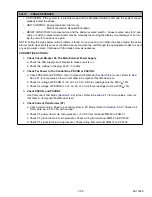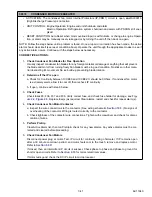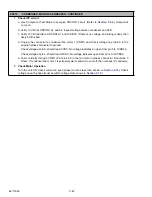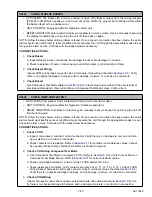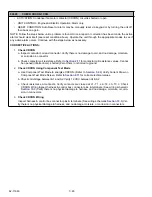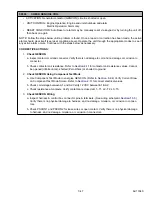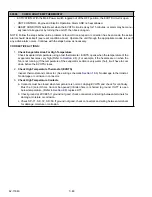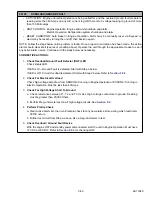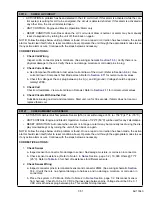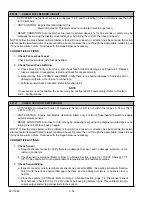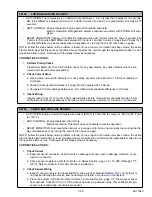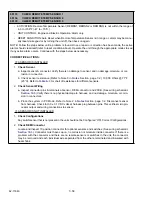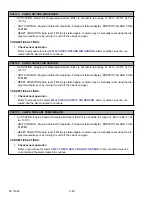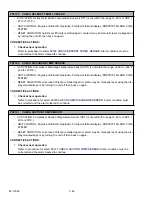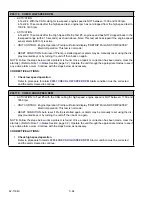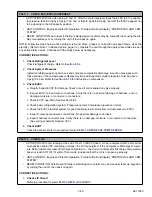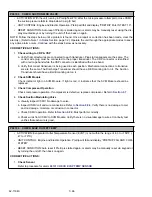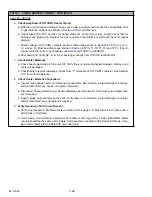
7–53
62-11640
00124
CHECK DEFROST TERM 1 SENSOR
• ACTIVATION: Defrost Termination Temperature Sensor (1DTT) is not within the range of -53° to +158°F
(-47° to +70° C.)
• UNIT CONTROL: Engine and Electric Operation: If Alarm 122 is not active: Alarm and initiate defrost if
1RAT is below 45°F (7.2°C). If Alarm 122 is also active: Alarm and initiate defrost if 1SAT is below 45°F
(7.2°C). Under both of the above conditions, defrost will end after 10 minutes. If Alarms 122 and 123 are
also both active: alarm and defrost will not be allowed.
• RESET CONDITION: Auto Reset when 1DTT is in range or, alarm may be manually reset via keypad or
by turning the unit off, then back on again.
NOTE: Follow the steps below until a problem is found. Once a repair or correction has been made, the active
alarm should clear itself (see reset condition above). Operate the unit through the appropriate modes to see if
any active alarm occurs. Continue with the steps below as necessary.
CORRECTIVE ACTIONS:
1.
Check Sensor
a. Inspect sensor & connectors. Verify there is no damage to sensor, and no damage, moisture, or
corrosion in connectors.
b. Check sensor resistance. (Refer to Note 3 in
Section, page 7-2.) 10,000 Ohms @ 77°F
for chart of resistances for different sensors.
2.
Check Sensor Wiring
a. Inspect harness & control box connector pins & terminals (See wiring schematic
(2MM3 & 2MM11) Verify there is no physical damage to harness, and no damage, moisture, or
corrosion in connectors.
b. Power up the microprocessor (Refer to Note 2 in
Section, page 7-2). Disconnect sensor
from harness. Check for Voltage 3.0 ± 0.1 VDC volts at harness plug between pins. This verifies
microprocessor output and wiring connections to the sensor.
00125
CHECK COMP DISCHARGE SENSOR
• ACTIVATION: Compressor Discharge Temperature Sensor (CDT) is not within the range of -40° to
+392°F (-40° to +200°C).
• UNIT CONTROL: Engine and Electric Operation: Alarm Only.
• RESET CONDITION: Auto reset when sensor is in range or, alarm may be manually reset using the dis-
play mounted keys or by turning the unit off, then back on again.
NOTE: Follow the steps below until a problem is found. Once a repair or correction has been made, the active
alarm should clear itself (refer to reset condition above). Operate the unit through the appropriate modes to see
if any active alarm occurs. Continue with the steps below as necessary.
CORRECTIVE ACTIONS:
1.
Check Sensor
a. Inspect sensor & connector. Verify there is no damage to sensor, and no damage, moisture, or cor-
rosion in connector.
b. Check sensor resistance. (Refer to Note 3 in
Section, page 7-2.) 90,000 Ohms @ 77°F
for chart of resistances for different sensors.
2.
Check Sensor Wiring
a. Inspect connector pins & terminals 2MM. (See wiring schematic
) Verify there is no
physical damage to harness, and no damage, moisture, or corrosion in connectors.
b. Place the system in PC Mode. Refer to Note 2 in
Section, page 7-2. Disconnect sensor
from harness. Check for 3.0 ± 0.1 VDC volts at harness plug between pins. This verifies micropro-
cessor output and wiring connections to the sensor.
Summary of Contents for Vector 8500
Page 23: ...62 11640 1 6 1 3 SAFETY DECALS ...
Page 24: ...1 7 62 11640 62 03958 ...
Page 25: ...62 11640 1 8 ...
Page 26: ...1 9 62 11640 ...
Page 27: ...62 11640 1 10 ...
Page 125: ...62 11640 SECTION 6 MESSAGECENTER PARAGRAPH NUMBER Page 6 1 MESSAGECENTER MESSAGES 6 1 ...
Page 321: ......
Page 322: ......

